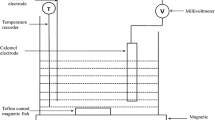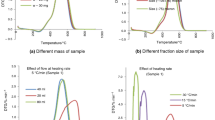Abstract
The paper presents the application of adaptive resonance theory of artificial neural networks (ANN) for classification of coal seams with respect to their proneness to spontaneous heating. In order to apply this technique, 31 coal samples have been collected from different Indian coalfields covering both fiery and non-fiery coal seams of varying ranks spreading over 8 different mining companies. The intrinsic properties of these samples have been determined by carrying out proximate, ultimate and petrographic analyses. The susceptibility indices of these samples have been studied by five different methods, viz. crossing point temperature, differential thermal analysis, critical air blast analysis, wet oxidation potential difference analysis and differential scanning calorimetric studies. Exhaustive correlation studies between susceptibility indices and the intrinsic properties have been carried out for identifying the appropriate spontaneous heating susceptibility indices and intrinsic properties to be used for classification of coal seams. The identified parameters are used as inputs and adaptive resonance theory of ANN has been applied to classify the coal seams into four different categories. This classification system will help the planners and practising mining engineers to take ameliorative measures in advance to prevent the occurrence of fire in mines.
Similar content being viewed by others
References
Banerjee, S. C. and Chakravarty, R. N. (1967) Use of D. T. A. in the study of spontaneous combustion of coal, Journal of Mines, Metals and Fuels, Jan., pp. 1-5.
Banerjee, S. C. (2000) Prevention and Combating Mine Fires, Oxford & IBH, New Delhi, p. 33.
Carpenter, G. A. and Grossberg, S. (1987) A massively parallel architecture for a self organising neural pattern recognition machine, Computer Vision, Graphics and Image Processing, 37, 54-115.
Gouws, M. J. and Wade, L. (1989) The Self-heating liability of coal:Prediction based on composite indices, Mining Science and Technology, 9, 81-85.
Indian Standard:9127, Part-II (1979) Methods for Petrographic Analysis of Coal:Pre-paration of Coal Samples for Petrographic Analysis, pp. 4-8.
Indian Standard:1350 (1975) Methods of Test for Coal and Coke:Ultimate Analysis, Determination of Nitrogen, pp. 3-10.
Indian Standard:1350, Part-I (1969) Methods of Test for Coal and Coke:Proximate Analysis, pp. 5-18.
Indian Standard:1350, Part-III (1969) Methods of Test for Coal and Coke:Determination of Sulphur, pp. 5-8.
Indian Standard:1350, Part-IV/Sec 1 (1974) Methods of Test for Coal and Coke:Ultimate Analysis, Determination of Carbon and Hydrogen, pp. 5-12.
Indian Standard:9127, Part-I (1979) Methods for Petrographic Analysis of Coal, pp. 5-7.
International Committee for Coal Petrography (1971) International Handbook of Coal Petrology, 2nd ed., C. N. R. S., Paris.
International Committee for Coal Petrography (1994) Vitrinite Classification, C. N. R. S., Paris.
Mahajan, O. P., Tomita, A. and Walker, P. L. (1976) Differential scanning calorimetry studies on coal. 1. Pyrolysis in an inert atmosphere, Fuel, 55, January, 63-69.
Panigrahi, D. C., Saxena, V. K. and Udaybhanu, G. (1999(a)) Research project report:development of handy method of coal categorisation and prediction of spontaneous fire risk in mines, Department of Mining Engineering, ISM, Dhanbad, Vol. 1, Dec., pp. 5-13.
Panigrahi, D. C., Saxena, V. K. and Udaybhanu, G. (1999(b)) Research project report:development of handy method of coal categorisation and prediction of spontaneous re risk in mines, Department of Mining Engineering, ISM, Dhanbad, Vol. 1, Dec., pp. 15-23.
Panigrahi, D. C., Udaybhanu, G. and Ojha, A. (1996) A comparative study of wet oxidation method and crossing point temperature method for determining the susceptibility of Indian coals to spontaneous heating, In:Proceedings:Seminar on Prevention and Control of Mine and Industrial Fires-Trends and Challenges, Calcutta, India, Dec., pp. 101-107.
Pao, Y. H. (1989) Adaptive Pattern Recognition and Neural Networks, Addison Wesley Publishing Company Inc., Reading, Massachusetts, pp. 178-182.
Stach, E., Machowsky, M. H., Teichmu¨ller, M., Taylor, G. H., Chandra, D. and Teichmu¨ller, R. (1982) Stach 's Textbook of Coal Petrology, Gebruder Borntraeger, Berlin, Stuttart, 3rd ed. pp. 87-135, pp. 181-201, pp. 294-327.
Stach, E., Machowsky, M. H., Teichmu¨ller, M., Taylor, G. H., Chandra, D. and Teichmu¨ller, R. (1975) Stach 's Textbook of Coal Petrology, Gebruder Borntraeger, Berlin, 2nd ed. pp. 387-388.
Tarafdar, M. N. and Guha, D. (1989) Application of wet oxidation processes for the assess-ment of the spontaneous heating of coal, Fuel, 68, March, pp. 315-317.
Zurada, J. M. (1996) Introduction to Artificial Neural Systems, Jaico Publishing House, Mumbai, pp. 432-445.
Author information
Authors and Affiliations
Rights and permissions
About this article
Cite this article
Panigrahi, D.C., Sahu, H.B. Classification of coal seams with respect to their spontaneous heating susceptibility—a neural network approach. Geotechnical and Geological Engineering 22, 457–476 (2004). https://doi.org/10.1023/B:GEGE.0000047040.70764.90
Issue Date:
DOI: https://doi.org/10.1023/B:GEGE.0000047040.70764.90




